Mary Anne Yarde's Blog: The Coffee Pot Book Club , page 196
September 27, 2017
#FolkloreThursday ~ The Cloak of Invisibility #Arthurian #myths #legends
I guess nowadays when we think of The Cloak of Invisibility we automatically think of Harry Potter. But did you know J.K. Rowling borrowed the idea from Folklore?
The Cloak of Invisibility is very common in German and Welsh mythology. I am going to stay with Wales for today's post because in the Welsh stories, the Cloak of Invisibility is owned by King Arthur.

Forget Excalibur, King Arthur's Mantle of Invisibility was one of his most prized possessions. There was no way Arthur was going to part with it. Harry Potter was of the same mind — he dropped the Resurrection Stone, broke the Elder Wand, but he kept the Invisibility Cloak!
The story of Arthur and his Mantle of Invisibility can be found in the Welsh story of Culhwch and Olwen c.1100. This cloak made the man wearing it invisible, although whoever was under the cloak could still see through the magic material. In this story, Arthur helps Culhwch complete his quest. Arthur gives Culhwch many things, but he will NOT part with his cloak!
 Culhwch at Ysbadadden's court ~ Wikipedia
Culhwch at Ysbadadden's court ~ Wikipedia
In The Dream of Rhonabwy (early 13th Century) the cloak is once again mentioned. This time the cloak goes by the name of Gwenn and it shrouds those who sit on it with invisibility!
The Cloak of Invisibility is one of the Thirteen Treasures of the Island of Briton. This treasure is hidden somewhere on Bardsey Island, Gwynedd, North Wales. But don't go getting your spades and metal detectors ready because Merlin is the guardian of the treasures and he takes that role very seriously!
 Bardsey Island ~ Wikipedia
Bardsey Island ~ Wikipedia
***
Why not travel back in time and check out the multi award-winning, Arthurian series ~
The Du Lac Chronicles
Only 0.99 each on Kindle for a Limited Time only!
Read for FREE with Kindle Unlimited
Pre-Order The Du Lac Princess (Book 3 of The Du Lac Chronicles)

Amazon US
Amazon UK
Amazon CA
The Cloak of Invisibility is very common in German and Welsh mythology. I am going to stay with Wales for today's post because in the Welsh stories, the Cloak of Invisibility is owned by King Arthur.

Forget Excalibur, King Arthur's Mantle of Invisibility was one of his most prized possessions. There was no way Arthur was going to part with it. Harry Potter was of the same mind — he dropped the Resurrection Stone, broke the Elder Wand, but he kept the Invisibility Cloak!
The story of Arthur and his Mantle of Invisibility can be found in the Welsh story of Culhwch and Olwen c.1100. This cloak made the man wearing it invisible, although whoever was under the cloak could still see through the magic material. In this story, Arthur helps Culhwch complete his quest. Arthur gives Culhwch many things, but he will NOT part with his cloak!
 Culhwch at Ysbadadden's court ~ Wikipedia
Culhwch at Ysbadadden's court ~ WikipediaIn The Dream of Rhonabwy (early 13th Century) the cloak is once again mentioned. This time the cloak goes by the name of Gwenn and it shrouds those who sit on it with invisibility!
The Cloak of Invisibility is one of the Thirteen Treasures of the Island of Briton. This treasure is hidden somewhere on Bardsey Island, Gwynedd, North Wales. But don't go getting your spades and metal detectors ready because Merlin is the guardian of the treasures and he takes that role very seriously!
 Bardsey Island ~ Wikipedia
Bardsey Island ~ Wikipedia***
Why not travel back in time and check out the multi award-winning, Arthurian series ~
The Du Lac Chronicles
Only 0.99 each on Kindle for a Limited Time only!
Read for FREE with Kindle Unlimited
Pre-Order The Du Lac Princess (Book 3 of The Du Lac Chronicles)

Amazon US
Amazon UK
Amazon CA
Published on September 27, 2017 23:00
Pre-Order The Du Lac Princess on #Kindle today! #HistFic
The Du Lac Princess(Book 3 of The Du Lac Chronicles)By Mary Anne Yarde

The multi award-winning series, The Du Lac Chronicles, continues…
War is coming…
The ink has dried on Amandine’s death warrant. Her crime? She is a du Lac.
All that stands in the way of a grisly death on a pyre is the King of Brittany. However, King Philippe is a fickle friend, and if her death is profitable to him, then she has no doubt that he would light the pyre himself.
Alan, the only man Amandine trusts, has a secret and must make an impossible choice, which could have far-reaching consequences — not only for Amandine, but for the whole of Briton.
Pre-Order your Kindle copy today!Amazon US Amazon UK
Catch up with The Du Lac Chronicles series.
O.99 each on Kindle for a limited time only.
Don’t miss out!

Links for Purchase Amazon US Amazon UK
 Mary Anne Yarde is an award winning author of the International Best Selling Series — The Du Lac Chronicles. Set a generation after the fall of King Arthur, The Du Lac Chronicles takes you on a journey through Dark Age Briton and Brittany, where you will meet new friends and terrifying foes. Based on legends and historical fact, the Du Lac Chronicles is a series not to be missed.
Mary Anne Yarde is an award winning author of the International Best Selling Series — The Du Lac Chronicles. Set a generation after the fall of King Arthur, The Du Lac Chronicles takes you on a journey through Dark Age Briton and Brittany, where you will meet new friends and terrifying foes. Based on legends and historical fact, the Du Lac Chronicles is a series not to be missed.Born in Bath, England, Mary Anne Yarde grew up in the southwest of England, surrounded and influenced by centuries of history and mythology. Glastonbury--the fabled Isle of Avalon--was a mere fifteen-minute drive from her home, and tales of King Arthur and his knights were part of her childhood.
Useful LinksFacebook Twitter Goodreads
Published on September 27, 2017 02:36
September 25, 2017
New Release ~ Heroines of the Medieval World #History #Medieval @Thehistorybits
Heroines of the Medieval World
by Sharon Bennett Connolly

These are the stories of women, famous, infamous and unknown, who shaped the course of medieval history. The lives and actions of medieval women were restricted by the men who ruled the homes, countries and world they lived in. It was men who fought wars, made laws and dictated religious doctrine. It was men who were taught to read, trained to rule and expected to fight.
Today, it is easy to think that all women from this era were downtrodden, retiring and obedient housewives, whose sole purpose was to give birth to children (preferably boys) and serve their husbands. Heroines of the Medieval World looks at the lives of the women who broke the mould: those who defied social norms and made their own future, consequently changing lives, society and even the course of history.
Some of the women are famous, such as Eleanor of Aquitaine, who was not only a duchess in her own right but also Queen Consort of France through her first marriage and Queen Consort of England through her second, in addition to being a crusader and a rebel. Then there are the more obscure but no less remarkable figures such as Nicholaa de la Haye, who defended Lincoln Castle in the name of King John, and Maud de Braose, who spoke out against the same king’s excesses and whose death (or murder) was the inspiration for a clause in Magna Carta.
Women had to walk a fine line in the Middle Ages, but many learned to survive – even flourish – in this male-dominated world. Some led armies, while others made their influence felt in more subtle ways, but all made a contribution to their era and should be remembered for daring to defy and lead in a world that demanded they obey and follow.
Links for Purchase
Amazon US
Amazon UK
About the author

Sharon Bennett Connolly, has been fascinated by history for over 30 years now. She has studied history academically and just for fun – and even worked as a tour guide at historical sites, including Conisbrough Castle.
Born in Yorkshire, she studied at University in Northampton before working in Customer Service roles at Disneyland in Paris and Eurostar in London.
She is now having great fun, passing on her love of the past to her son, hunting dragons through Medieval castles or exploring the hidden alcoves of Tudor Manor Houses.
For Christmas 2014, her husband gave her her very own blog – History ... the Interesting Bits allowing her to indulge in that love of history. Sharon started researching and writing about the lesser-known stories and people from European history, the stories that have always fascinated. Quite by accident, she started focusing on medieval women. And in 2016 she was given the opportunity to write her first non-fiction book, Heroines of the Medieval World, which will be published by Amberley in September 2017.Useful LinksBlog Facebook Twitter
by Sharon Bennett Connolly

These are the stories of women, famous, infamous and unknown, who shaped the course of medieval history. The lives and actions of medieval women were restricted by the men who ruled the homes, countries and world they lived in. It was men who fought wars, made laws and dictated religious doctrine. It was men who were taught to read, trained to rule and expected to fight.
Today, it is easy to think that all women from this era were downtrodden, retiring and obedient housewives, whose sole purpose was to give birth to children (preferably boys) and serve their husbands. Heroines of the Medieval World looks at the lives of the women who broke the mould: those who defied social norms and made their own future, consequently changing lives, society and even the course of history.
Some of the women are famous, such as Eleanor of Aquitaine, who was not only a duchess in her own right but also Queen Consort of France through her first marriage and Queen Consort of England through her second, in addition to being a crusader and a rebel. Then there are the more obscure but no less remarkable figures such as Nicholaa de la Haye, who defended Lincoln Castle in the name of King John, and Maud de Braose, who spoke out against the same king’s excesses and whose death (or murder) was the inspiration for a clause in Magna Carta.
Women had to walk a fine line in the Middle Ages, but many learned to survive – even flourish – in this male-dominated world. Some led armies, while others made their influence felt in more subtle ways, but all made a contribution to their era and should be remembered for daring to defy and lead in a world that demanded they obey and follow.
Links for Purchase
Amazon US
Amazon UK
About the author

Sharon Bennett Connolly, has been fascinated by history for over 30 years now. She has studied history academically and just for fun – and even worked as a tour guide at historical sites, including Conisbrough Castle.
Born in Yorkshire, she studied at University in Northampton before working in Customer Service roles at Disneyland in Paris and Eurostar in London.
She is now having great fun, passing on her love of the past to her son, hunting dragons through Medieval castles or exploring the hidden alcoves of Tudor Manor Houses.
For Christmas 2014, her husband gave her her very own blog – History ... the Interesting Bits allowing her to indulge in that love of history. Sharon started researching and writing about the lesser-known stories and people from European history, the stories that have always fascinated. Quite by accident, she started focusing on medieval women. And in 2016 she was given the opportunity to write her first non-fiction book, Heroines of the Medieval World, which will be published by Amberley in September 2017.Useful LinksBlog Facebook Twitter
Published on September 25, 2017 23:00
#bookreview ~ Fools and Mortals #Shakespeare #HistFic @BernardCornwell
Fools and Mortals By Bernard Cornwell

A dramatic new departure for international bestselling author Bernard Cornwell, FOOLS AND MORTALS takes us into the heart of the Elizabethan era, long one of his favourite periods of British history.
Fools and Mortals follows the young Richard Shakespeare, an actor struggling to make his way in a company dominated by his estranged older brother, William. As the growth of theatre blooms, their rivalry – and that of the playhouses, playwrights and actors vying for acclaim and glory – propels a high-stakes story of conflict and betrayal.
Showcasing his renowned storyteller’s skill, Bernard Cornwell has created an Elizabethan world incredibly rich in its portrayal: you walk the London streets, stand in the palaces and are on stage in the playhouses, as he weaves a remarkable story in which performances, rivalries and ambition combine to form a tangled web of intrigue.
What did I think of the Book?
“Lord, what fools these mortals be…”
Running away from Stratford-Upon-Avon seemed like a sensible thing to do at the time. Richard Shakespeare was sure that his eldest brother, William, would be glad to see him. Alas, that was not the case. But he was here now. There was nothing William could do about that. Following in his brother's footsteps, Richard becomes a player as well as the occasional thief.
As the years roll on, Richard Shakespeare becomes more and more discouraged. He is way past the age of playing the girl parts in his brother’s plays, but William insists that he play them. When William finally casts Richard in his first male role, Richard is overjoyed. But this was William they were talking about, Richard should have known there would be a catch. Now Richard has a decision to make, should he stay with the Lord Chamberlain's men, or should he leave them to join Langley and his new impressive theatre, The Swan?
Rich with historical detail and with characters that leap off the page, Fools and Mortals by Bernard Cornwell is a must for all fans of Shakespeare and the Elizabethan era.
The story is told from Richard Shakespeare perspective, and therefore it does not portray William in such a great light. Fans of William Shakespeare be warned! The story itself is very fast in the telling, and it was so gripping that I read this book in a day and I have to say that I enjoyed every minute of it.
Fools and Mortals reminded me greatly of the 1998 period costume drama Shakespeare in Love. There was the same feel to it, except the play in the spotlight this time is A Midsummer Nights Dream.
Mr. Cornwell depicts in great detail what it may well have been like to be a player in Elizabethan England. It was very believable and very real in the telling. Kudos Mr. Cornwell!
The story itself is full of intrigue and plots between the rival playhouses. There is, of course, the ever-present threat of the zealous Protestants who wanted to see the playhouses close for good. There is also a sweet romance.
The Last Kingdom it is not, but for fans of Shakespeare, and the Elizabethan era it is a must read.
I Highly Recommend.
*I received a copy of this book from the publishers, via Netgalley, for review consideration.”
Available for Pre-OrderAmazon US Amazon UK
About the author
 Bernard Cornwell was born in London in 1944 – a ‘warbaby’ – whose father was a Canadian airman and mother in Britain’s Women’s Auxiliary Air Force.
Bernard Cornwell was born in London in 1944 – a ‘warbaby’ – whose father was a Canadian airman and mother in Britain’s Women’s Auxiliary Air Force.He was adopted by a family in Essex who belonged to a religious sect called the Peculiar People (and they were), but escaped to London University and, after a stint as a teacher, he joined BBC Television where he worked for the next 10 years.
He began as a researcher on the Nationwide programme and ended as Head of Current Affairs Television for the BBC in Northern Ireland. It was while working in Belfast that he met Judy, a visiting American, and fell in love. Judy was unable to move to Britain for family reasons so Bernard went to the States where he was refused a Green Card. He decided to earn a living by writing, a job that did not need a permit from the US government – and for some years he had been wanting to write the adventures of a British soldier in the Napoleonic wars – and so the Sharpe series was born. Bernard and Judy married in 1980, are still married, still live in the States and he is still writing Sharpe.Useful Links
WebsiteTwitter
Published on September 25, 2017 05:41
September 24, 2017
Blog Tour ~ Raven's Feast #histfic #Vikings @hfvbt @DArkAgeScribe @CreativiaPub
Book Blast ~ Historical Virtual Book Tour Presents....

Raven's Feast
by Eric Schumacher

Raven’s Feast is the sequel to God’s Hammer, the true story of Hakon Haraldsson and his quest to win and keep the High Seat of Viking Age Norway.
It is 935 A.D. and Hakon Haraldsson has just wrested the High Seat of the North from his ruthless brother, Erik Bloodaxe. Now, he must fight to keep it.
The land-hungry Danes are pressing from the south to test Hakon before he can solidify his rule. In the east, the Uplanders are making their own plans to seize the throne. It does not help that Hakon is committed to his dream of Christianizing his people – a dream his countrymen do not share and will fight to resist.
As his enemies move in and his realm begins to crumble, Hakon and his band of oath-sworn warriors must make a stand in Raven’s Feast, the riveting sequel to God’s Hammer.
“At its core, Raven’s Feast is more than a story about a young king holding firm to the power he has won in Viking Norway,” said Eric Schumacher, author of Raven’s Feast. “It is the story of a young man holding true to one’s self and convictions in the face of extreme challenges — something to which, I hope, many people can relate.”
Praise for God's Hammer
“Eric Schumacher has created the most evocative tale in his stunning novel — God’s Hammer. This book completely drew me in. The research that has gone into God’s Hammer has to be commended, and it is incredibly rich in historical detail. It was as if I was looking through a window into the past as I read the pages of this remarkable story. Hakon’s portrayal is both realistic and believable. Schumacher has obviously researched the life of Hakon in great detail, and this certainly came through in the writing. Schumacher brought Hakon back to life. Well Done!”
Mary Yarde, the author of The Du Lac Chronicles
“Author Eric Schumacher put together a rousing story of warfare, religious strife and tested friendships.”
Mercedes Rochelle, author of Godwine Kingmaker and The Sons of Godwine
What did I think of the book?
After the battle, the war begins...
Despite the odds, Hakon Haraldsson won the High Seat of the North from his brother, Erik Bloodaxe. But one battle does not make a king. Hakon now has to bring the divided Jarls together under his leadership if he has any hope of retaining his right to the throne. At the same time he has to ensure the safety of his people, a task easier said than done.
Eric Schumacher has done it again. He has given us a story that practically screams realism. Raven's Feast is so rich in historical detail that it is like a personal portal to the past. The world Mr Schumacher has created is both vivid and believable. It really felt as if I had travelled to the 10th Century while I turned the pages of this remarkable book.
I loved the characterisation on Hakon Haraldsson in God's Hammer, and it was wonderful to watch his character develop further in Raven's Feast. Despite some rather disastrous mistakes, he has all the makings of a great King.
The story is incredibly fast paced. The pages simply flew by as I became more immersed in the story. This is a sit-down and finish book.
If you love Vikings, then this series should be on your to read list.
I Highly Recommend.
Links for Purchase
Amazon Barnes and Noble IndieBound
Giveaway
During the Blog Tour we will be giving away a signed paperback copy of Raven’s Feast!
Enter here
Giveaway Rules*Giveaway ends at 11:59pm EST on September 25th. You must be 18 or older to enter.*Giveaway is open INTERNATIONALLY.*Only one entry per household.*All giveaway entrants agree to be honest and not cheat the systems; any suspect of fraud is decided upon by blog/site owner and the sponsor, and entrants may be disqualified at our discretion.*Winner has 48 hours to claim prize or new winner is chosen.
About the author

Eric Schumacher was born in Los Angeles in 1968 and currently resides in Santa Barbara, CA with his wife, two children and dog. He is the author of two historical fiction novels, God’s Hammer and its sequel, Raven’s Feast. Both tell the story of the first Christian king of Viking Norway, Hakon Haraldsson, and his struggles to gain and hold the High Seat of his realm.Useful LinkswebsiteTwitterFacebookGoodreads
AuthorsDB.
Raven’s Feast by Eric SchumacherPublication Date: May 1, 2017 Creativia eBook & PaperbackSeries: Hakon’s Saga, Book 2 Genre: Fiction/Historical

Raven's Feast
by Eric Schumacher

Raven’s Feast is the sequel to God’s Hammer, the true story of Hakon Haraldsson and his quest to win and keep the High Seat of Viking Age Norway.
It is 935 A.D. and Hakon Haraldsson has just wrested the High Seat of the North from his ruthless brother, Erik Bloodaxe. Now, he must fight to keep it.
The land-hungry Danes are pressing from the south to test Hakon before he can solidify his rule. In the east, the Uplanders are making their own plans to seize the throne. It does not help that Hakon is committed to his dream of Christianizing his people – a dream his countrymen do not share and will fight to resist.
As his enemies move in and his realm begins to crumble, Hakon and his band of oath-sworn warriors must make a stand in Raven’s Feast, the riveting sequel to God’s Hammer.
“At its core, Raven’s Feast is more than a story about a young king holding firm to the power he has won in Viking Norway,” said Eric Schumacher, author of Raven’s Feast. “It is the story of a young man holding true to one’s self and convictions in the face of extreme challenges — something to which, I hope, many people can relate.”
Praise for God's Hammer
“Eric Schumacher has created the most evocative tale in his stunning novel — God’s Hammer. This book completely drew me in. The research that has gone into God’s Hammer has to be commended, and it is incredibly rich in historical detail. It was as if I was looking through a window into the past as I read the pages of this remarkable story. Hakon’s portrayal is both realistic and believable. Schumacher has obviously researched the life of Hakon in great detail, and this certainly came through in the writing. Schumacher brought Hakon back to life. Well Done!”
Mary Yarde, the author of The Du Lac Chronicles
“Author Eric Schumacher put together a rousing story of warfare, religious strife and tested friendships.”
Mercedes Rochelle, author of Godwine Kingmaker and The Sons of Godwine
What did I think of the book?
After the battle, the war begins...
Despite the odds, Hakon Haraldsson won the High Seat of the North from his brother, Erik Bloodaxe. But one battle does not make a king. Hakon now has to bring the divided Jarls together under his leadership if he has any hope of retaining his right to the throne. At the same time he has to ensure the safety of his people, a task easier said than done.
Eric Schumacher has done it again. He has given us a story that practically screams realism. Raven's Feast is so rich in historical detail that it is like a personal portal to the past. The world Mr Schumacher has created is both vivid and believable. It really felt as if I had travelled to the 10th Century while I turned the pages of this remarkable book.
I loved the characterisation on Hakon Haraldsson in God's Hammer, and it was wonderful to watch his character develop further in Raven's Feast. Despite some rather disastrous mistakes, he has all the makings of a great King.
The story is incredibly fast paced. The pages simply flew by as I became more immersed in the story. This is a sit-down and finish book.
If you love Vikings, then this series should be on your to read list.
I Highly Recommend.
Links for Purchase
Amazon Barnes and Noble IndieBound
Giveaway
During the Blog Tour we will be giving away a signed paperback copy of Raven’s Feast!
Enter here
Giveaway Rules*Giveaway ends at 11:59pm EST on September 25th. You must be 18 or older to enter.*Giveaway is open INTERNATIONALLY.*Only one entry per household.*All giveaway entrants agree to be honest and not cheat the systems; any suspect of fraud is decided upon by blog/site owner and the sponsor, and entrants may be disqualified at our discretion.*Winner has 48 hours to claim prize or new winner is chosen.
About the author

Eric Schumacher was born in Los Angeles in 1968 and currently resides in Santa Barbara, CA with his wife, two children and dog. He is the author of two historical fiction novels, God’s Hammer and its sequel, Raven’s Feast. Both tell the story of the first Christian king of Viking Norway, Hakon Haraldsson, and his struggles to gain and hold the High Seat of his realm.Useful LinkswebsiteTwitterFacebookGoodreads
AuthorsDB.
Raven’s Feast by Eric SchumacherPublication Date: May 1, 2017 Creativia eBook & PaperbackSeries: Hakon’s Saga, Book 2 Genre: Fiction/Historical
Published on September 24, 2017 23:00
September 20, 2017
#FolkloreThursday ~ Angels or Angles? #Bede #England #history
Todays story was first recorded for prosperity by the Venerable Bede in his great work, Ecclesiastical History Of The English People, and can be found in Book 2 Chapter 1.
Rome 597c.
The market in Rome was bustling as it always was. Traders came from near and afar to sell their goods. If you wanted a chicken or a length of silk, then this was the place where you could purchase it. How about a new horse or perhaps some sheep? Do you have the coins to purchase some exotic spices? And if all your purchases become too cumbersome to carry, then you could always buy a slave to carry your goods home.

Amongst the slaves were two children. These children caught the eye of Brother Gregory. These boys were different to the other slaves. They were so very white of skin, and their hair was very fair.

"Where are they from?" he asked the slave dealer.
"They are from Angli," the slave dealer replied. "They are hard working and will serve you well."
"I have no need for slaves," Brother Gregory answered. "These children are beautiful, look at their angelic faces."
The slave dealer laughed at Brother Gregory's words. "Believe me they are no angels, and they are no Christians. They are heathens."

"Their King, what is his name?" Brother Gregory asked.
The slave dealer scratched his chin as he thought. "King Ella, I believe.”
"King Ella," Brother Gregory repeated and then he laughed. "’Alleluia, the praise of God the Creator must be sung in those parts..." With that, he walked away and immediately sought an audience with the Pope.
Brother Gregory explained about the children he had seen in the marketplace, and he asked the Pope if he could go to this pagan island that the slave dealer had told him about. It was his Christian duty to introduce these pagans to God.
The Pope refused. Brother Gregory was too important to leave Rome. Brother Gregory sighed his discontent, but he did not cross the Pope.
Many years later, the Pope died and much to his surprise, Brother Gregory became the new Bishop of Rome. But despite all those years, he had not forgotten those angelic children that he had seen in the marketplace.
 Pope Gregory ~ Wikipedia
Pope Gregory ~ Wikipedia
He summoned Brother Augustine, and he commanded him to take forty monks and travel to the land of the pagans and spread the Good News of Christ.
But during the long and arduous journey to the land of the pagans, the monks lost faith in their mission, for they had heard terrible things about this country. They petitioned Pope Gregory asking if they could return to Rome. Their answer was an unequivocal "No."
The Christian monk's soldiered on. They had only a small silver cross to protect them. They landed at Ramsgate and sent word to King Ethelbert of Kent.

King Ethelbert was intrigued so agreed to meet them, but there were conditions. King Ethelbert feared these monks would use magic to seduce him to their way of thinking, so he demanded they were to meet out of doors.

But Brother Augustine needed no magic, for he had God. The people were soon flocking to hear him preach. With the help of his fellow monks, the population converted to Christianity. Pope Gregory, it seemed, had been right all along.
Refrences:’Alleluia, the praise of God the Creator must be sung in those parts..." ~ Bedes, Ecclesiastical History Of The English People
All images, unless otherwise stated, can be found on Pixabay
***
Why not travel back in time and check out the multi award-winning, Arthurian series ~
The Du Lac Chronicles
Read for FREE with Kindle Unlimited

Amazon US
Amazon UK
Amazon CA
Rome 597c.
The market in Rome was bustling as it always was. Traders came from near and afar to sell their goods. If you wanted a chicken or a length of silk, then this was the place where you could purchase it. How about a new horse or perhaps some sheep? Do you have the coins to purchase some exotic spices? And if all your purchases become too cumbersome to carry, then you could always buy a slave to carry your goods home.

Amongst the slaves were two children. These children caught the eye of Brother Gregory. These boys were different to the other slaves. They were so very white of skin, and their hair was very fair.

"Where are they from?" he asked the slave dealer.
"They are from Angli," the slave dealer replied. "They are hard working and will serve you well."
"I have no need for slaves," Brother Gregory answered. "These children are beautiful, look at their angelic faces."
The slave dealer laughed at Brother Gregory's words. "Believe me they are no angels, and they are no Christians. They are heathens."

"Their King, what is his name?" Brother Gregory asked.
The slave dealer scratched his chin as he thought. "King Ella, I believe.”
"King Ella," Brother Gregory repeated and then he laughed. "’Alleluia, the praise of God the Creator must be sung in those parts..." With that, he walked away and immediately sought an audience with the Pope.
Brother Gregory explained about the children he had seen in the marketplace, and he asked the Pope if he could go to this pagan island that the slave dealer had told him about. It was his Christian duty to introduce these pagans to God.
The Pope refused. Brother Gregory was too important to leave Rome. Brother Gregory sighed his discontent, but he did not cross the Pope.
Many years later, the Pope died and much to his surprise, Brother Gregory became the new Bishop of Rome. But despite all those years, he had not forgotten those angelic children that he had seen in the marketplace.
 Pope Gregory ~ Wikipedia
Pope Gregory ~ WikipediaHe summoned Brother Augustine, and he commanded him to take forty monks and travel to the land of the pagans and spread the Good News of Christ.
But during the long and arduous journey to the land of the pagans, the monks lost faith in their mission, for they had heard terrible things about this country. They petitioned Pope Gregory asking if they could return to Rome. Their answer was an unequivocal "No."
The Christian monk's soldiered on. They had only a small silver cross to protect them. They landed at Ramsgate and sent word to King Ethelbert of Kent.

King Ethelbert was intrigued so agreed to meet them, but there were conditions. King Ethelbert feared these monks would use magic to seduce him to their way of thinking, so he demanded they were to meet out of doors.

But Brother Augustine needed no magic, for he had God. The people were soon flocking to hear him preach. With the help of his fellow monks, the population converted to Christianity. Pope Gregory, it seemed, had been right all along.
Refrences:’Alleluia, the praise of God the Creator must be sung in those parts..." ~ Bedes, Ecclesiastical History Of The English People
All images, unless otherwise stated, can be found on Pixabay
***
Why not travel back in time and check out the multi award-winning, Arthurian series ~
The Du Lac Chronicles
Read for FREE with Kindle Unlimited

Amazon US
Amazon UK
Amazon CA
Published on September 20, 2017 23:00
September 19, 2017
Author’s Inspiration ~ Paula Lofting #HistFic #mustread @paulalofting
I have historical fiction author, Paula Lofting, on the blog today. Paula is going to share with us her inspiration behind her fabulous series…Sons of the Wolf

Sometimes the enemy is closer and far more shadowy and dangerous than any battle or war…
Sons of the Wolf is a series set in the years leading up to the end of Anglo-Saxon rule when the ineffective and indolent Edward the Confessor sits on the throne, indulging in such pleasures as hunting, feasting and praying, whilst his leading earl, Harold Godwinson administrates the kingdom for him, working hard to ensure the safety of England against those who would attack her.
Against this backdrop, Sussex thegn and king’s warrior, Wulfhere, is caught up in a feud with his neighbour, Helghi, who casts his covetous eyes over Wulfhere’s homestead and plots the downfall of his family. When Lord Harold demands that the two enemies end the feud by wedding their son and daughter, Wulfhere fights to extricate himself and his beloved daughter, Freyda, from the bargain he has been forced into entering, without compromising his honour and loyalty to his lord.
Can Wulfhere save Freyda from Helghi’s evil clutches and remain true to his lord? Will Helghi’s evil intentions stop at Freyda or will he want more of what Wulfhere has than is daughter?
Author’s Inspiration
Books have always been more than just words on a page and paper in a binder, for living inside those pages, is the magic that exists inside all of us. Everyone has within them the power to create anything they wish – worlds with all kinds of amazing wonderments: islands, cities, undulating hills; snow-capped mountains surrounded by lush forests with their hidden magic; sun-reflected lakes; waterfalls that cascade into deep blue lagoons that stretch into rivers that snake through valleys of green marshy slopes. I could go on, but it would take forever to list all the amazing things that a story or a fairy tale brings to our imaginations. These were the places inhabiting my mind as a child finding escape and adventure in a book.

I was a huge bookworm. I remember Dad would take me to the library on a Saturday, and I spent ages there, looking at the books and grabbing the ones with covers that caught my eyes. I would choose books by Rosemary Sutcliffe, C.S. Lewis and anything that looked fascinating with a historical element and I especially loved stories about dragons, faraway places, and animals that could talk, like in Rupert Bear.

By the time I was a teenager, I had discovered one of my most favourite authors. I was still reading books by Rosemary Sutcliffe, stories I adored. She kindled the spark that would one day turn into a fierce love of all things past. But by now, I had found Leon Garfield, who managed to captivate my imagination, and took me from the post Roman-British world of Rosemary Sutcliffe to the streets of London in the 18thc. Sutcliffe and Garfield both wrote books in historical settings for adolescents, and these books were extremely erudite for my tender years, even for a seasoned reader, but oh how they sparked my imagination, leaving me to fulfil my desire for more, by creating stories of my own which I would write down in an exercise book. I went on to read and discover many more wonderful authors as I grew older.

Like most avid readers, I wrote a lot. One day I started on a post Roman-Britain epic about Ambrosius Aurelianus, that I never got around to finishing, but wrote 500 pages or so by hand. By the time I was in my 20s, I’d lost my aspirations of writing forever when I sadly chose to forget ever being a writer because, a) I thought I wasn’t good enough b) I would never be able to afford a typewriter that was worth its salt, and c) life events took over.
It was not until a lot of water and hardship had gone under the bridge that I reached an age where I was in a position to actually do something about my dream of writing a historical novel. After dealing with some personal issues, I found myself at college learning to use a computer which opened the door to a lot of things for me. For some reason, I’d stopped reading for a while and when I started again, I realised my old passion for history and books had never gone away, remaining in a corner of my mind for years, just waiting for me to call to it again. I’d lost the impetus with the post-Romano book, so I decided to find a period I could write about that hadn’t been written about much before. I explored the medieval era and gained interest in the 12th – 15th centuries.

To keep a long story short, I began my journey to writing when I was training to be a nurse, but it wasn’t until a re-enactment of the Battle of Hastings that I found my new obsession. I was so affected by that day, all I could think about for days was what happened to those ordinary men a thousand years ago and the injustice of it all. I craved to have more knowledge, and no other dynasty would do. My heart was firmly stuck in the 11thc. Inspired, I found myself joining a re-enactment society which doubly enhanced my research of this period. Nowadays, I see it this way, what can my writing bring to my re-enacting.

The book that was to become my first baby was written in 6 years. 3 of those years coincided with my nurse training. It was the longest book ever, something like 320,000 words which I eventually made into two books. I decided that because it had taken me 6 years to write as it was, I wasn’t going to waste more time trying to find an agent and then waiting more years whilst they looked for a deal for me, that’s if I even managed to find an agent! Someone recommended an assisted publisher, which was not the best decision I ever made, due to the cost I was never going to recoup in sales. In those days, I was naïve and too eager to get my book published. I would not pay to publish again. My book was called Sons of the Wolf and was set in the years before the Battle of Hastings and was centred around a character called Wulfhere, the thegn of Horstede who owned the land almost a thousand years ago in a village near to where I live in Sussex. I read about him first in a book by David Howarth, 1066: The Year of The Conquest. I looked him up in the Domesday Book and decided that he would be my main character, creating a family for him and a backstory. The only thing known of him was that he held the village of Horstede (now called Little Horsted) and 5 hides of land and his property of ploughs and oxen, how many tenants he had owing service to him. The story I created for him becomes entwined with those of the historical characters, Harold Godwinson, and Edward the Confessor, being just two. It is a family saga in which we follow both the fortunes of Wulfhere and his lord, Earl Harold, and their families. Later I was to republish Sons of the Wolf and its’ sequel, The Wolf Banner under my own publishing imprint, Longship Publishing. I am much happier working under my own company with like-minded friends whom support each other and also publish under the name. I am currently working on the third in the series, Wolf’s Bane.
For me writing is a hobby, something to do in my spare time. It’s an escape, something I can do to bolster my self-esteem and help me get these wonderful characters and their doings out of my head and into their world. I work in quite a stressful job and it allows me to relax and do to people the things I couldn’t do to them in real life! I my writing I can go where I want to, be who I want to, and be part of the past, whichever past I would like it to be. I wish it could be my sole profession, but alas, that’s not possible right now. But who knows, maybe one day I will sell enough to establish myself part time. We will have to see

Links for Purchase
Amazon US
Amazon UK
About the author

Born in Middlesex, Paula emigrated as a child with her family to South Australia where she went to school and grew up. There she discovered her imagination and love of books. She returned to the country of her birth, the UK, and now lives in Sussex. She is a psychiatric nurse by day, re-enactor with Regia Anglorum by weekend, and a writing demon by night and in her spare time.Paula’s advice to newbee writers:
"It’s a big world that writers live in, with lots of competition. This is what I tell myself, write for enjoyment, don’t write to make money. Write for yourself, regardless of what is popular and selling; for if you don't write what you love, then how can you expect others to love what you write."
Useful Links Blog FacebookTwitter

Sometimes the enemy is closer and far more shadowy and dangerous than any battle or war…
Sons of the Wolf is a series set in the years leading up to the end of Anglo-Saxon rule when the ineffective and indolent Edward the Confessor sits on the throne, indulging in such pleasures as hunting, feasting and praying, whilst his leading earl, Harold Godwinson administrates the kingdom for him, working hard to ensure the safety of England against those who would attack her.
Against this backdrop, Sussex thegn and king’s warrior, Wulfhere, is caught up in a feud with his neighbour, Helghi, who casts his covetous eyes over Wulfhere’s homestead and plots the downfall of his family. When Lord Harold demands that the two enemies end the feud by wedding their son and daughter, Wulfhere fights to extricate himself and his beloved daughter, Freyda, from the bargain he has been forced into entering, without compromising his honour and loyalty to his lord.
Can Wulfhere save Freyda from Helghi’s evil clutches and remain true to his lord? Will Helghi’s evil intentions stop at Freyda or will he want more of what Wulfhere has than is daughter?
Author’s Inspiration
Books have always been more than just words on a page and paper in a binder, for living inside those pages, is the magic that exists inside all of us. Everyone has within them the power to create anything they wish – worlds with all kinds of amazing wonderments: islands, cities, undulating hills; snow-capped mountains surrounded by lush forests with their hidden magic; sun-reflected lakes; waterfalls that cascade into deep blue lagoons that stretch into rivers that snake through valleys of green marshy slopes. I could go on, but it would take forever to list all the amazing things that a story or a fairy tale brings to our imaginations. These were the places inhabiting my mind as a child finding escape and adventure in a book.

I was a huge bookworm. I remember Dad would take me to the library on a Saturday, and I spent ages there, looking at the books and grabbing the ones with covers that caught my eyes. I would choose books by Rosemary Sutcliffe, C.S. Lewis and anything that looked fascinating with a historical element and I especially loved stories about dragons, faraway places, and animals that could talk, like in Rupert Bear.

By the time I was a teenager, I had discovered one of my most favourite authors. I was still reading books by Rosemary Sutcliffe, stories I adored. She kindled the spark that would one day turn into a fierce love of all things past. But by now, I had found Leon Garfield, who managed to captivate my imagination, and took me from the post Roman-British world of Rosemary Sutcliffe to the streets of London in the 18thc. Sutcliffe and Garfield both wrote books in historical settings for adolescents, and these books were extremely erudite for my tender years, even for a seasoned reader, but oh how they sparked my imagination, leaving me to fulfil my desire for more, by creating stories of my own which I would write down in an exercise book. I went on to read and discover many more wonderful authors as I grew older.

Like most avid readers, I wrote a lot. One day I started on a post Roman-Britain epic about Ambrosius Aurelianus, that I never got around to finishing, but wrote 500 pages or so by hand. By the time I was in my 20s, I’d lost my aspirations of writing forever when I sadly chose to forget ever being a writer because, a) I thought I wasn’t good enough b) I would never be able to afford a typewriter that was worth its salt, and c) life events took over.
It was not until a lot of water and hardship had gone under the bridge that I reached an age where I was in a position to actually do something about my dream of writing a historical novel. After dealing with some personal issues, I found myself at college learning to use a computer which opened the door to a lot of things for me. For some reason, I’d stopped reading for a while and when I started again, I realised my old passion for history and books had never gone away, remaining in a corner of my mind for years, just waiting for me to call to it again. I’d lost the impetus with the post-Romano book, so I decided to find a period I could write about that hadn’t been written about much before. I explored the medieval era and gained interest in the 12th – 15th centuries.

To keep a long story short, I began my journey to writing when I was training to be a nurse, but it wasn’t until a re-enactment of the Battle of Hastings that I found my new obsession. I was so affected by that day, all I could think about for days was what happened to those ordinary men a thousand years ago and the injustice of it all. I craved to have more knowledge, and no other dynasty would do. My heart was firmly stuck in the 11thc. Inspired, I found myself joining a re-enactment society which doubly enhanced my research of this period. Nowadays, I see it this way, what can my writing bring to my re-enacting.

The book that was to become my first baby was written in 6 years. 3 of those years coincided with my nurse training. It was the longest book ever, something like 320,000 words which I eventually made into two books. I decided that because it had taken me 6 years to write as it was, I wasn’t going to waste more time trying to find an agent and then waiting more years whilst they looked for a deal for me, that’s if I even managed to find an agent! Someone recommended an assisted publisher, which was not the best decision I ever made, due to the cost I was never going to recoup in sales. In those days, I was naïve and too eager to get my book published. I would not pay to publish again. My book was called Sons of the Wolf and was set in the years before the Battle of Hastings and was centred around a character called Wulfhere, the thegn of Horstede who owned the land almost a thousand years ago in a village near to where I live in Sussex. I read about him first in a book by David Howarth, 1066: The Year of The Conquest. I looked him up in the Domesday Book and decided that he would be my main character, creating a family for him and a backstory. The only thing known of him was that he held the village of Horstede (now called Little Horsted) and 5 hides of land and his property of ploughs and oxen, how many tenants he had owing service to him. The story I created for him becomes entwined with those of the historical characters, Harold Godwinson, and Edward the Confessor, being just two. It is a family saga in which we follow both the fortunes of Wulfhere and his lord, Earl Harold, and their families. Later I was to republish Sons of the Wolf and its’ sequel, The Wolf Banner under my own publishing imprint, Longship Publishing. I am much happier working under my own company with like-minded friends whom support each other and also publish under the name. I am currently working on the third in the series, Wolf’s Bane.
For me writing is a hobby, something to do in my spare time. It’s an escape, something I can do to bolster my self-esteem and help me get these wonderful characters and their doings out of my head and into their world. I work in quite a stressful job and it allows me to relax and do to people the things I couldn’t do to them in real life! I my writing I can go where I want to, be who I want to, and be part of the past, whichever past I would like it to be. I wish it could be my sole profession, but alas, that’s not possible right now. But who knows, maybe one day I will sell enough to establish myself part time. We will have to see

Links for Purchase
Amazon US
Amazon UK
About the author

Born in Middlesex, Paula emigrated as a child with her family to South Australia where she went to school and grew up. There she discovered her imagination and love of books. She returned to the country of her birth, the UK, and now lives in Sussex. She is a psychiatric nurse by day, re-enactor with Regia Anglorum by weekend, and a writing demon by night and in her spare time.Paula’s advice to newbee writers:
"It’s a big world that writers live in, with lots of competition. This is what I tell myself, write for enjoyment, don’t write to make money. Write for yourself, regardless of what is popular and selling; for if you don't write what you love, then how can you expect others to love what you write."
Useful Links Blog FacebookTwitter
Published on September 19, 2017 23:00
September 18, 2017
‘Droughtlander’ is official over!! #Outlander #Scotland
By Mary Anne Yarde
So the long ‘Droughtlander’ is official over, and it is back on our screens. Thank goodness! This series promises to be as amazing as the last. Check out the trailer...
Outlander | Season 3 Official Trailer |STARZ
Last September I found myself in Scotland and I could not but help checking out some of the fabulous Historical sites where Outlander was filmed, and I thought I would share some photographs with you today!!
Doune Castle - Stirling
I was in heaven. I had Sam Heughan chatting away in my ear (the audio guide), explaining how Doune Castle was turned into Castle Leoch. What more could a girl want?!
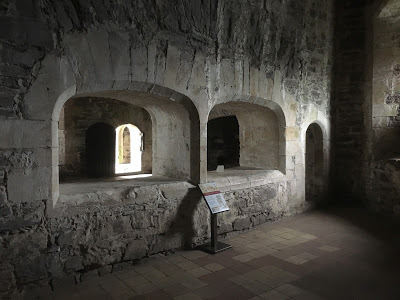 Mrs. Fitz's Kitchen
Mrs. Fitz's Kitchen

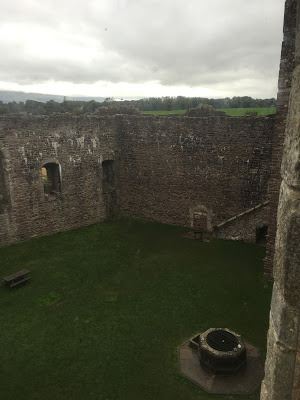


If you have limited time in Scotland and want to go to just one Outlander location, then go here. Castle Doune, not only has the most incredible history, but there is something special about this place ~ although that might have been down to Jamie Fraser ~ I mean Sam Heughan ~ giving me my very own personal guided tour...hey, a girl can dream can't she?
Hopetoun House – Edinburgh
 Hopetoun House was used as a location for the Duke of Sandringham's house, and boy, was it impressive. The tour guide brought the history of the house to life, and it is beautiful. Well worth a visit, and the views from the roof are amazing, or so I am told, I had my eyes closed for most of it ~ if you are a regular reader then you will know I am terrified of heights!
Hopetoun House was used as a location for the Duke of Sandringham's house, and boy, was it impressive. The tour guide brought the history of the house to life, and it is beautiful. Well worth a visit, and the views from the roof are amazing, or so I am told, I had my eyes closed for most of it ~ if you are a regular reader then you will know I am terrified of heights!


Blackness Castle – Edinburgh

Blackness Castle was used on location as Fort William Prison, and I can see why. Blackness Castle is incredibly atmospheric. It was a little bit damp when we went, which did make it a little bit slippery underfoot, but definitely worth a look.
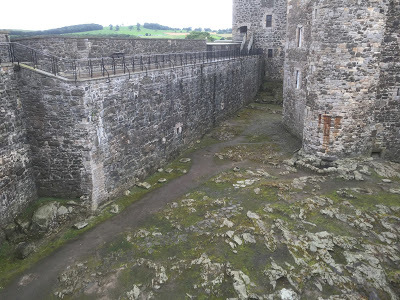

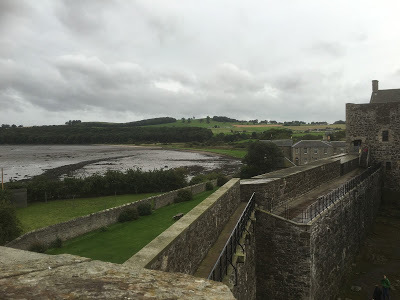
Troon Beach – Ayrshire
Can you remember that scene where Jamie and Clare are forced to flee Scotland and say goodbye to their friends on the beach? Troon Beach was where this scene was filmed. This was a disappointing one for me because as soon as we pulled into the car park the heavens opened. Needless to say, we didn't stay there long, because it was really cold and wet ~ but at least I can say I have been! Unfortunately I don't have any photographs to share with you. Sorry about that!
Preston Mill –Edinburgh
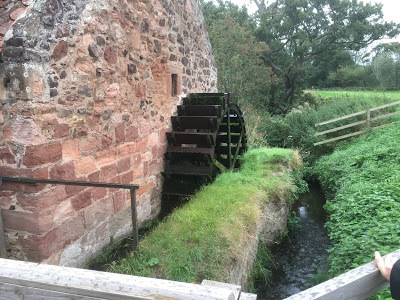
Jamie found his way home to Lallybroch, and he had to make repairs to the watermill.
I have been to that mill!! YAY!
You have to take the guided tour when you look around the mill, as it is an actual working mill, which I think is incredible. I learnt so much about watermills, and the tour guide was fabulous. Thumbs Up for this one!
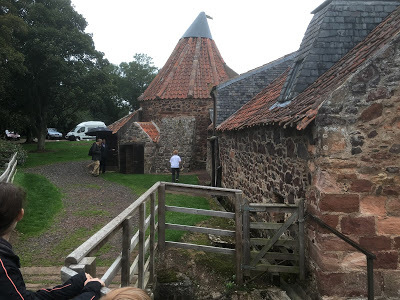
If you fancy going back even further in time then why not check out The Du Lac Chronicles series?

FREE with Kindle Unlimited Subscription.
Amazon USAmazon UK
So the long ‘Droughtlander’ is official over, and it is back on our screens. Thank goodness! This series promises to be as amazing as the last. Check out the trailer...
Outlander | Season 3 Official Trailer |STARZ
Last September I found myself in Scotland and I could not but help checking out some of the fabulous Historical sites where Outlander was filmed, and I thought I would share some photographs with you today!!
Doune Castle - Stirling

I was in heaven. I had Sam Heughan chatting away in my ear (the audio guide), explaining how Doune Castle was turned into Castle Leoch. What more could a girl want?!
 Mrs. Fitz's Kitchen
Mrs. Fitz's Kitchen



If you have limited time in Scotland and want to go to just one Outlander location, then go here. Castle Doune, not only has the most incredible history, but there is something special about this place ~ although that might have been down to Jamie Fraser ~ I mean Sam Heughan ~ giving me my very own personal guided tour...hey, a girl can dream can't she?
Hopetoun House – Edinburgh
 Hopetoun House was used as a location for the Duke of Sandringham's house, and boy, was it impressive. The tour guide brought the history of the house to life, and it is beautiful. Well worth a visit, and the views from the roof are amazing, or so I am told, I had my eyes closed for most of it ~ if you are a regular reader then you will know I am terrified of heights!
Hopetoun House was used as a location for the Duke of Sandringham's house, and boy, was it impressive. The tour guide brought the history of the house to life, and it is beautiful. Well worth a visit, and the views from the roof are amazing, or so I am told, I had my eyes closed for most of it ~ if you are a regular reader then you will know I am terrified of heights!

Blackness Castle – Edinburgh

Blackness Castle was used on location as Fort William Prison, and I can see why. Blackness Castle is incredibly atmospheric. It was a little bit damp when we went, which did make it a little bit slippery underfoot, but definitely worth a look.



Troon Beach – Ayrshire
Can you remember that scene where Jamie and Clare are forced to flee Scotland and say goodbye to their friends on the beach? Troon Beach was where this scene was filmed. This was a disappointing one for me because as soon as we pulled into the car park the heavens opened. Needless to say, we didn't stay there long, because it was really cold and wet ~ but at least I can say I have been! Unfortunately I don't have any photographs to share with you. Sorry about that!
Preston Mill –Edinburgh

Jamie found his way home to Lallybroch, and he had to make repairs to the watermill.
I have been to that mill!! YAY!
You have to take the guided tour when you look around the mill, as it is an actual working mill, which I think is incredible. I learnt so much about watermills, and the tour guide was fabulous. Thumbs Up for this one!

If you fancy going back even further in time then why not check out The Du Lac Chronicles series?

FREE with Kindle Unlimited Subscription.
Amazon USAmazon UK
Published on September 18, 2017 23:00
September 17, 2017
#bookreview ~ Traitor's Knot #HistFic #CivilWar #ASMSG @CryssaBazos
Traitor’s KnotBy Cryssa Bazos

England 1650: Civil War has given way to an uneasy peace in the year since Parliament executed King Charles I.
Royalist officer James Hart refuses to accept the tyranny of the new government, and to raise funds for the restoration of the king’s son, he takes to the road as a highwayman.
Elizabeth Seton has long been shunned for being a traitor’s daughter. In the midst of the new order, she risks her life by sheltering fugitives from Parliament in a garrison town. But her attempts to rebuild her life are threatened, first by her own sense of injustice, then by falling in love with the dashing Hart.
The lovers’ loyalty is tested through war, defeat and separation. James must fight his way back to the woman he loves, while Elizabeth will do anything to save him, even if it means sacrificing herself.
Traitor's Knot is a sweeping tale of love and conflicted loyalties set against the turmoil of the English Civil War.
What did I think of the book?
For King, For Country, And For The Woman He Loves…
James Hart may appear to be a hardworking ostler, but it could not be farther from the truth. He is, in fact, a Royalist officer and a renowned highwayman. He is determined to see the rightful King back on the throne of England and if he has to steal from the Puritans pockets to do so, then so be it!
Elisabeth Seton has lost everything. Her home, her family, and her honour. Her father fought on the losing side during the Civil War, and now she is regarded as the traitor’s daughter. She will live with the shame for that is her lot to bear, but then a chance meeting with a highwayman changes her life forever and gives her a reason to hope.
There are some books that when you turn the pages, everything else is suddenly not so important. You get lost in the story, as you watch the events unfold in front of you. Traitor’s Knot by Cryssa Bazos is such a book.
Set during the reign of Cromwell, Ms. Bazos takes you on the most fascinating and compelling journey as she weaves a story of what it was like to be a Royalist in the time of the Puritan rule. The attention to historical detail has to be commended. It seems that nothing escaped Ms. Bazos attention. The hours of research that have gone into this book has certainly paid off. Ms. Bazos has brought the era to life.
This book has a large cast of characters, all of which were very well drawn. The two protagonists, James and Elisabeth, were so real in the telling that when someone brings up this era in conversation the first thing that will spring to mind, from now on, are these two fictional characters — that is how good they have been portrayed.
I have to say bravo to Ms. Bazos at her portrayal of Hammond. Hammond is probably the best portrayal of an antagonist that I have ever read. His mind is so corrupted that he twists the teachings of the Bible to accuse innocent men and women of the most horrendous crimes, when the real crime was what he was committing. But of course, he is blind to his wrongdoing but sees evil in everyone else. He is the perfect character to go up against our brave heroes.
The story is very compelling. So much happens in this book and near the end I was dreading turning the pages, fearing what was going to happen next. The action is non-stop, from battles to marketplaces. From royalty to the poorest of the poor. From filthy jails to beautiful countryside. From violence to romance. This book has something for everyone.
As I was reading Traitor’s Knot, I could not help but think of the great classic, Launa Doone by Richard Doddridge Blackmore. It had the same feel to it — that same desperate but compelling need to carry on turning those pages. Traitor’s Knot would make a fabulous mini-series on the television. It would certainly be a must watch.
Needless to say, I LOVED it. It is certainly in the top 5 books I have read and reviewed so far this year.
I Highly Recommend.
Links for PurchaseAmazon USAmazon UK
About the author
 Cryssa Bazos is an award winning historical fiction writer and 17th century enthusiast with a particular interest in the English Civil War. She is a member of the Historical Novel Society, the Romantic Novelist Association and is a co-editor and contributor of the English Historical Fiction Authors blog. Her debut novel, Traitor's Knot, is published by Endeavour Press. For more stories, visit her blog cryssabazos.comUseful Links
Cryssa Bazos is an award winning historical fiction writer and 17th century enthusiast with a particular interest in the English Civil War. She is a member of the Historical Novel Society, the Romantic Novelist Association and is a co-editor and contributor of the English Historical Fiction Authors blog. Her debut novel, Traitor's Knot, is published by Endeavour Press. For more stories, visit her blog cryssabazos.comUseful Links
Website Facebook Twitter Instagram

England 1650: Civil War has given way to an uneasy peace in the year since Parliament executed King Charles I.
Royalist officer James Hart refuses to accept the tyranny of the new government, and to raise funds for the restoration of the king’s son, he takes to the road as a highwayman.
Elizabeth Seton has long been shunned for being a traitor’s daughter. In the midst of the new order, she risks her life by sheltering fugitives from Parliament in a garrison town. But her attempts to rebuild her life are threatened, first by her own sense of injustice, then by falling in love with the dashing Hart.
The lovers’ loyalty is tested through war, defeat and separation. James must fight his way back to the woman he loves, while Elizabeth will do anything to save him, even if it means sacrificing herself.
Traitor's Knot is a sweeping tale of love and conflicted loyalties set against the turmoil of the English Civil War.
What did I think of the book?
For King, For Country, And For The Woman He Loves…
James Hart may appear to be a hardworking ostler, but it could not be farther from the truth. He is, in fact, a Royalist officer and a renowned highwayman. He is determined to see the rightful King back on the throne of England and if he has to steal from the Puritans pockets to do so, then so be it!
Elisabeth Seton has lost everything. Her home, her family, and her honour. Her father fought on the losing side during the Civil War, and now she is regarded as the traitor’s daughter. She will live with the shame for that is her lot to bear, but then a chance meeting with a highwayman changes her life forever and gives her a reason to hope.
There are some books that when you turn the pages, everything else is suddenly not so important. You get lost in the story, as you watch the events unfold in front of you. Traitor’s Knot by Cryssa Bazos is such a book.
Set during the reign of Cromwell, Ms. Bazos takes you on the most fascinating and compelling journey as she weaves a story of what it was like to be a Royalist in the time of the Puritan rule. The attention to historical detail has to be commended. It seems that nothing escaped Ms. Bazos attention. The hours of research that have gone into this book has certainly paid off. Ms. Bazos has brought the era to life.
This book has a large cast of characters, all of which were very well drawn. The two protagonists, James and Elisabeth, were so real in the telling that when someone brings up this era in conversation the first thing that will spring to mind, from now on, are these two fictional characters — that is how good they have been portrayed.
I have to say bravo to Ms. Bazos at her portrayal of Hammond. Hammond is probably the best portrayal of an antagonist that I have ever read. His mind is so corrupted that he twists the teachings of the Bible to accuse innocent men and women of the most horrendous crimes, when the real crime was what he was committing. But of course, he is blind to his wrongdoing but sees evil in everyone else. He is the perfect character to go up against our brave heroes.
The story is very compelling. So much happens in this book and near the end I was dreading turning the pages, fearing what was going to happen next. The action is non-stop, from battles to marketplaces. From royalty to the poorest of the poor. From filthy jails to beautiful countryside. From violence to romance. This book has something for everyone.
As I was reading Traitor’s Knot, I could not help but think of the great classic, Launa Doone by Richard Doddridge Blackmore. It had the same feel to it — that same desperate but compelling need to carry on turning those pages. Traitor’s Knot would make a fabulous mini-series on the television. It would certainly be a must watch.
Needless to say, I LOVED it. It is certainly in the top 5 books I have read and reviewed so far this year.
I Highly Recommend.
Links for PurchaseAmazon USAmazon UK
About the author
 Cryssa Bazos is an award winning historical fiction writer and 17th century enthusiast with a particular interest in the English Civil War. She is a member of the Historical Novel Society, the Romantic Novelist Association and is a co-editor and contributor of the English Historical Fiction Authors blog. Her debut novel, Traitor's Knot, is published by Endeavour Press. For more stories, visit her blog cryssabazos.comUseful Links
Cryssa Bazos is an award winning historical fiction writer and 17th century enthusiast with a particular interest in the English Civil War. She is a member of the Historical Novel Society, the Romantic Novelist Association and is a co-editor and contributor of the English Historical Fiction Authors blog. Her debut novel, Traitor's Knot, is published by Endeavour Press. For more stories, visit her blog cryssabazos.comUseful Links Website Facebook Twitter Instagram
Published on September 17, 2017 23:00
September 15, 2017
New Release ~ Postcards from London #historical #contemporary @timwalker1666
Postcards from LondonBy Tim Walker
 The city of London is the star of this collection of fifteen engaging stories from author Tim Walker. Drawing on the vivid history of the city where he has both lived and worked, Postcards from London celebrates the magnificently multifaceted metropolis that is home to 8.8 million people.
The city of London is the star of this collection of fifteen engaging stories from author Tim Walker. Drawing on the vivid history of the city where he has both lived and worked, Postcards from London celebrates the magnificently multifaceted metropolis that is home to 8.8 million people.Imagine Iron Age fishermen, open-mouthed to see Roman galleys, rowed by slaves, dropping anchor at their village - a place the Romans would turn into the port and fortified town of Londinium. These Romans were the first of many men of vision who would come to shape the city we see today.
London’s long and complex history almost defies imagination, but the author has conjured citizens from many familiar eras, and some yet to be imagined. Turn over these picture postcards to explore his city through a collage of human dramas told in a range of genres. See the tumult of these imagined lives spotlighted at moments in London’s past, present and, who knows, perhaps its future.
Links for Purchase
Amazon USAmazon UK
About the author

Tim Walker is an independent multi-genre author based near Windsor, in the UK. This book, Ambrosius: Last of the Romans, is part two in a three-part historical fiction series under the series title, A Light in the Dark Ages. Part one, Abandoned! is available from Amazon, with part three, Uther’s Destiny, soon to follow.
He has also written and published a children’s book, The Adventures of Charly Holmes, co-authored with his daughter, Cathy; a book of short stories, Thames Valley Tales, and a dystopian thriller, Devil Gate Dawn.Useful Links Website Amazon Author Page Facebook
Published on September 15, 2017 23:00
The Coffee Pot Book Club
The Coffee Pot Book Club (formally Myths, Legends, Books, and Coffee Pots) was founded in 2015. Our goal was to create a platform that would help Historical Fiction, Historical Romance and Historical
The Coffee Pot Book Club (formally Myths, Legends, Books, and Coffee Pots) was founded in 2015. Our goal was to create a platform that would help Historical Fiction, Historical Romance and Historical Fantasy authors promote their books and find that sometimes elusive audience. The Coffee Pot Book Club soon became the place for readers to meet new authors (both traditionally published and independently) and discover their fabulous books.
...more
...more
- Mary Anne Yarde's profile
- 159 followers



